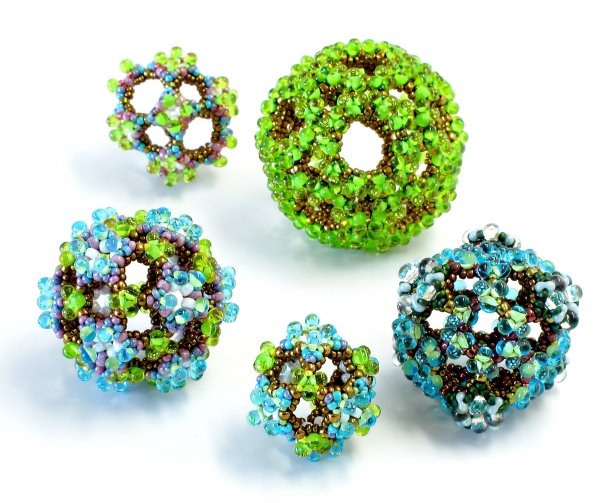Inventing Bead Polyhedra
(The text below is Copyright Valerie Hector 2015. All rights reserved.)
Small pendant or pei-jing made of silver, Chinese glass beads and amber (?), ca. 1900. Image courtesy Artist Magazine, Taipei, Taiwan. The hollow beaded sphere is a dodecahedron.
Quantum Leap #12: The Invention oF Bead Polyhedra
Time: Qing Dynasty (1644-1911) (or earlier)
Place: China
During the mid-Qing dynasty (1644-1911), artisans in the employ of the Chinese imperial court were stitching beads into hollow, symmetrical spherical structures. As far as I know, this had never been done before, anywhere else in the world. Moreover, China's role in the history of bead polyhedra has been overlooked.
Thanks to Laura Shea, Gwen Fisher and others, we now call this class of beaded structures "bead polyhedra." (There are many different types of bead polyhedra - do a Google image search!) Below, samples of Gwen's work (left) and Laura's work (right).
One structure in particular seems to have been favored in Qing dynasty China: the Platonic solid known as the dodecahedron, which consists of 12 adjacent rings of five beads each for a total of 30 beads. We see bead dodecahedra occasionally in hair ornaments worn by ladies of the Qing court. We also see them in small ornaments such as the one shown above. Other Platonic solids appearing in Qing-era beadwork include the cube, octahedron and icosahedron.
Were the Chinese aware that they were rendering geometric structures in beads? Further research is needed before this question can be answered. However, I'd be inclined to say yes, since the mathematical sciences were highly developed in China.
By the early 20th century, more complex bead polyhedra were being created in China. The evidence that survives suggests that most or all of these complex structures were symmetrical in nature.
Now, in the early 21st century, asymmetrical bead polyhedra are being made in China by everyday people who have taken up beading as a hobby. All sorts of hollow structures are being developed and used to render small human figures, animals, buildings, motorcycles, and so on. The advances are so significant that they will be addressed in a future Quantum Leap.
Detail of small hollow beaded gourd made in China, ca. 1900 AD, of Chinese glass beads strung on wire to form a complex, symmetrical geometric structure. Photo: Valerie Hector. Image Copyright Valerie Hector 2015. All rights reserved.
A "quasicrystal" from The Beaded Molecules website. Image courtesy The Beaded Molecules.
A Taiwanese publication featuring the work of Professor Jin and his students.







